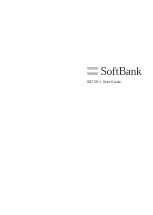
LGC-340/345W
22
LGIC
LG Information & Communications, Ltd.
CDMA analog I and Q baseband components are converted to digital signals by 2 4-bit ADCs.The ADCs output
a new 4-bit parallel digital value on each rising edge of the ADCs synchronous clock input signal,CHIP
×
8.
The CHIP
×
8 ADC clock frequency of 9.8304 MHz is developed in the IFR3000 by multiplying the 19.68MHz
system crystal oscillator frequency by 512/1025.
At the 2 4 bit ADCs, Q_OFFSET and I_OFFSET signals are inputted to MSM3000.
These signals are very important during the digital signal processing process of receive signal paths and
accordingly, the adjustment should be made in such a way that the MSM3000 detects the difference from ADC
digital output RXID[3:0] and RXQD[3:0] and then, generates PDM (Pulse Density Modulation) signals for
compensating the variation. This PDM signal passes the single-pole RC LPF and then, is converted into DV
voltage before being inputted to the I-OFFSET and Q-OFFSET terminals of the IFR3000.
1.2.4.2 FM Rx Signal Path
The Fm received signal Path is designed to accept a differential IF signal with frequency modulation extending
±
15kHz from the IF center frequency to form a 30Hz wide IF channel. The IF center frequency is same as the
CDMA IF center frequency, 85.38MHz.
The RX AGC amplifier interface with the IF subsystem of the subscriber unit. The Rx AGC either amplifiers or
attenuates the received FM IF signal to provide a constant amplitude.
Constant amplitude signals go through the I/Q downconverter.
The AGC amplifier conditions the received IF signal to optimize between low IF output power level and high
signal intellegibility and reliability. The AGC gain is controlled by varing a DC voltage on the Vcontrol input pin.
The AGC’s 90dB dynamic range is availiable over the full power supply range of the device.
The IF output of the Rx AGC amplifier is separated into I-Channel and Q-channel baseband compoments and
downconverted by mixing with quadrature local oscilliator signals.
The I and Q phasing of the receive section is spectrally inverted form a standard quadrature demodulator when
the IF input signal frequency is above the IF center frequency.
The I/Q down converter outputs the FM signals at baseband frequency. Low pass filtering enables the receiver to
select the desired baseband signal from the jamming effects of unwanted noise or adjacent-channel interference.
FM analog I and Q baseband components are converted to digital FM(DFM) signals by two 8-bit ADCs. The FM
ADCs’ outputs are inputted into MSM3000 through RXIFMDATA and RXQFMDATA terminals.








































